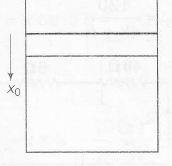Answer:
Option C
Explanation:
In equilibrium
P0A= Mg when slightly displaced downwards,

$dp=-y(\frac{p_{0}}{V_{0}})dV$
( As in adibatic process, $\frac{dp}{dV}=-y\frac{p}{V}$
Restoring forces,
$F= (dp)A=-\left(\frac{yp_{0}}{V_{0}}\right)(A)(Ax)$
$F\propto -x$
Therefore, motion is simple harmonic comparing with F= -Kx we have:
$K= \frac{yp_{0}A^{2}}{V_{0}}$
$\therefore$ $ f=\frac{1}{2\pi} \sqrt{\frac{K}{m}}=\frac{1}{2\pi}\sqrt{\frac{yp_{0}A^{2}}{MV_{0}}}$